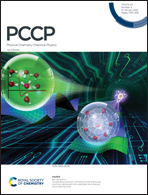Photoelectron spectroscopy and theoretical study of AlnC5−/0 (n = 1–5) clusters: structural evolution, relative stability of star-like clusters, and planar tetracoordinate carbon structures†
Abstract
The AlnC5− (n = 1–5) clusters were detected in the gas-phase and were investigated via mass-selected anion photoelectron spectroscopy. The structures of AlnC5−/0 (n = 1–5) were explored by theoretical calculations. It is found that the structures of AlC5−/0 and Al2C5−/0 are linear while those of Al3C5−/0, Al4C5−/0, and Al5C5−/0 are two-dimensional. The most stable structures of AlC5−/0 and Al2C5−/0 are linear with the Al atoms attached to the ends of C5 chain. The most stable structures of Al3C5−/0 can be viewed as three Al atoms interacting with a nonlinear C5 chain. The most stable structure of Al4C5− anion is a planar structure composed of a C2 unit, a C3 unit, and two Al2 units, while that of the neutral Al4C5 cluster has four Al atoms connected to different positions of a distorted C5 chain. The global minimum structures of Al5C5−/0 are planar structures composed of an Al4C quadrilateral, two C2 groups, and an Al atom connected to two C2 groups. Planar tetracoordinate carbon (ptC) has been identified in the structures of both anionic and neutral Al5C5. It is worth mentioning that the star-like structure of Al5C5− is slightly higher in energy than the ground state structure. The comparison of theoretical calculations with the experimental spectra indicates the star-like structure of Al5C5− may also appear in our experiments.

- This article is part of the themed collection: 2021 PCCP HOT Articles


 Please wait while we load your content...
Please wait while we load your content...